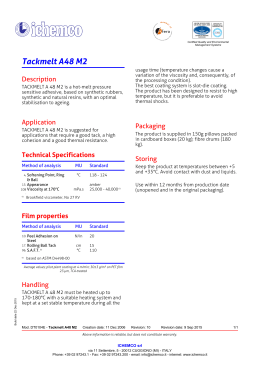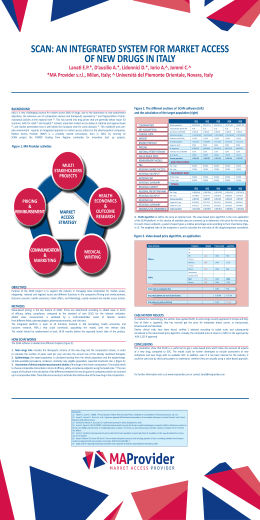LO SVILUPPO SOSTENIBILE NELL’AREA EURO-MEDITERRANEA Valutazione di impatto sanitario European Commission IMPACT ASSESSEMENT GUIDELINES 15 January 2009 Caltanissetta, 20-22 Settembre 2010 How to use these Guidelines? These Guidelines are for Commission staff preparing impact assessments. They consist of a core text (this document) and annexes. The core text explains what IA is, presents the key actors, sets out the procedural rules for preparing, carrying out and presenting an IA, and gives guidance on the analytical steps to follow in the IA work The annexes contain more detailed guidance that may also be of help. Additional guidance material to help with analysing specific impacts Caltanissetta, 20-22 Settembre 2010 Where to find more advice and support? These Guidelines should provide answers to many of your questions. The IA support unit/function in your DG will also be a key source of help and should be your central contact point for all IA related questions. For general questions on IA, you should contact the Secretariat General’s Impact Assessment Unit (SG.C.2). The Impact Assessment Board (IAB) can also be consulted on methodological issues Caltanissetta, 20-22 Settembre 2010 IMPACT ASSESSMENT BASICS AND PROCEDURES Caltanissetta, 20-22 Settembre 2010 What is impact assessment? In doing an IA, you will have to answer a number of questions: What is the nature and scale of the problem, how is it evolving, and who is most affected by it? What are the views of the stakeholders concerned? Should the Union be involved? If so, what objectives should it set to address the problem? What are the main policy options for reaching these objectives? What are the likely economic, social and environmental impacts of those options? How do the main options compare in terms of effectiveness, efficiency and coherence in solving the problems? How could future monitoring and evaluation be organised? Caltanissetta, 20-22 Settembre 2010 Presenting the findings: The IA report Caltanissetta, 20-22 Settembre 2010 …in the following format Caltanissetta, 20-22 Settembre 2010 Defining the problem The problem definition should describe and provide evidence of the nature and scale of the problem. You should identify the actors, sectors and social groups that are primarily affected by it…. Some of the major reasons for public intervention are presented in the box below Caltanissetta, 20-22 Settembre 2010 Developing a baseline scenario Sensitivity analysis Caltanissetta, 20-22 Settembre 2010 Risk Assessment Decision-makers are often faced with the need to reduce or eliminate the risk of adverse effects to the environment or to health. When the problem you are dealing with is affected by risk, i.e. you can attach probabilities to different possible outcomes; the IA will have to include a risk assessment as a tool to determine the best policy to deal with this. As a working definition you can equate the value of a given risk with the magnitude of the hazard, multiplied by the probability that it will occur. When the hazard under consideration may have consequences that are not yet fully scientifically established, and that may be irreversible, a full risk assessment by a scientific committee is necessary. In such cases, particularly when risks to the environment and human, animal and plant health are involved, the 'precautionary principle' may be applied as a first step towards the management of risk Caltanissetta, 20-22 Settembre 2010 WHAT ARE THE POLICY OBJECTIVES? Caltanissetta, 20-22 Settembre 2010 Caltanissetta, 20-22 Settembre 2010 The three steps of impact analysis Caltanissetta, 20-22 Settembre 2010 Step 1 Identify, economic, social and environmental impacts of a policy, why they occur and who is affected Caltanissetta, 20-22 Settembre 2010 Caltanissetta, 20-22 Settembre 2010 Caltanissetta, 20-22 Settembre 2010 Caltanissetta, 20-22 Settembre 2010 Step 2 Identifying the more important impacts The assessment of impacts in this step is generally qualitative. In this approach, you should: Identify the areas in which the proposed action is intended to produce benefits, as well as the areas where this may lead to direct costs or unintended negative impacts. Assign likelihoods (e.g. low, medium or high probability) that the impact will occur (or conversely the risk that the impact will not occur). This can be done by setting out your assumptions about factors that may influence the probability that impacts will occur, but which are outside the control of those managing the intervention. Assess and estimate the magnitude of each impact (providing reasonable ranges). This can be done by considering the influence of the intervention on the behaviour of addressees and vis-à-vis the socio-economic and environmental context in which the intervention takes place. Ask yourself whether some of the impacts could be irreversible (See also Annex 12 on the precautionary principle). Assess the importance of impacts on the basis of the two preceding elements (e.g. from low likelihood/low magnitude through to high likelihood/high impact). The causal model described in Annex 11.2 provides a basis on which you can identify the main drivers and causal links underlying the impacts you have identified Caltanissetta, 20-22 Settembre 2010 Step 3 In-depth analysis of the most significant impacts Building on the structured, qualitative analysis of step 2, further in-depth analyses should be undertaken to produce a quantitative/monetaryestimate of expected benefits and costs. This can take a number of forms: In-depth analysis of expected impacts over time which typically requires a case study/scenario approach. This type of analysis can be implemented on its own, though in reality it is generally used in conjunction with a quantitative analysis of impacts. Quantitative estimation of impacts: the impacts are estimated using quantitative techniques, …. Essentially, the aim is to understand the extent of the impacts of the policy options and to estimate the costs and benefits in monetary form when this is feasible… If quantification/monetisation is not feasible, explain why. Caltanissetta, 20-22 Settembre 2010 HOW DO THE OPTIONS COMPARE? Caltanissetta, 20-22 Settembre 2010 Ranking the options Caltanissetta, 20-22 Settembre 2010 ARRANGEMENTS FOR FUTURE MONITORING AND EVALUATION Policy makers need to be able to check if implementation is ‘on track’, and the extent to which the policy is achieving its objectives…Indicators must serve a clear purpose, i.e. measuring to what extent a policy has been properly implemented and its objectives achieved. Another important factor in choosing your indicators is the ease with which data can be collected; collecting data should not be more costly than the value of the information they provide. Caltanissetta, 20-22 Settembre 2010 ……commenti (*) (*) Katherine E Smith, Gary Fooks, Jeff Collinet al. Is the increasing policy use of Impact Assessment in Europe likely to undermine efforts to achieve healthy public policy? J Epidemiol Community Health 2010;64:478e487. doi:10.1136/jech.2009.094300 Caltanissetta, 20-22 Settembre 2010 Commenti a priori Negli ultimi anni un grosso interesse si è concentrato negli organismi UE e nei paesi membri sull’uso della IA (Impact Assessment). Significativo è stato l’aver attribuito particolare importanza alla BIA (Business IA) e alla RIA (Regulatory IA) rispetto alla HIA (Health IA). L’aver incorporato la EIA (Enviromental IA), BIA e la SIA (Social IA, entro cui è compresa la HIA) ha consentito alla Commissione di promuovere questo approccio come approfondito e complessivo. E’ indiscutibile che il peso attribuito al BIA e sicuramente superiore al SIA Caltanissetta, 20-22 Settembre 2010 Risultati Sulla base di una revisione di 300 articoli concernenti queste valutazioni a priori “eight fundamental concerns about IA and their relevance to IA in the EU” sono state identificate: 1. 2. 3. 4. 5. 6. 7. 8. The difficulties in predicting ex-ante policy impacts Information asymmetry Valuing non-market goods in economic terms Accounting for the distribution of impacts Reducing the potential for the ‘precautionary principle’ to serve as the basis for legislation The resources required to undertake IA Stakeholder involvement A tool to delay and challenge regulation Caltanissetta, 20-22 Settembre 2010 Conclusioni If we accept that HIA increases ‘the probability that the impact of policies is more likely to benefit than to harm health,’ the public health community needs to do more to ensure that HIAs are undertaken or sufficiently incorporated into ‘integrated’ IAs. Caltanissetta, 20-22 Settembre 2010
Scarica



